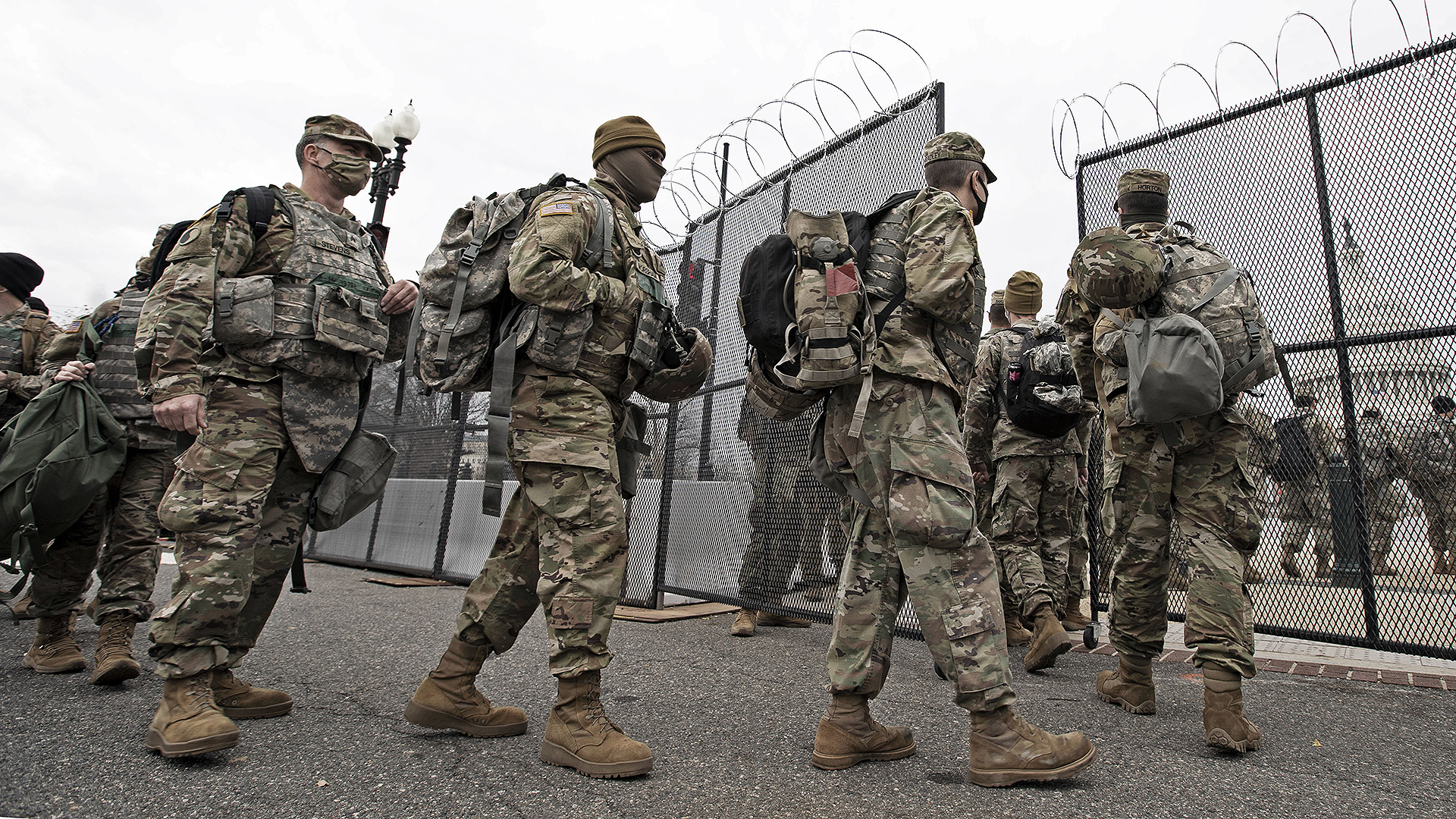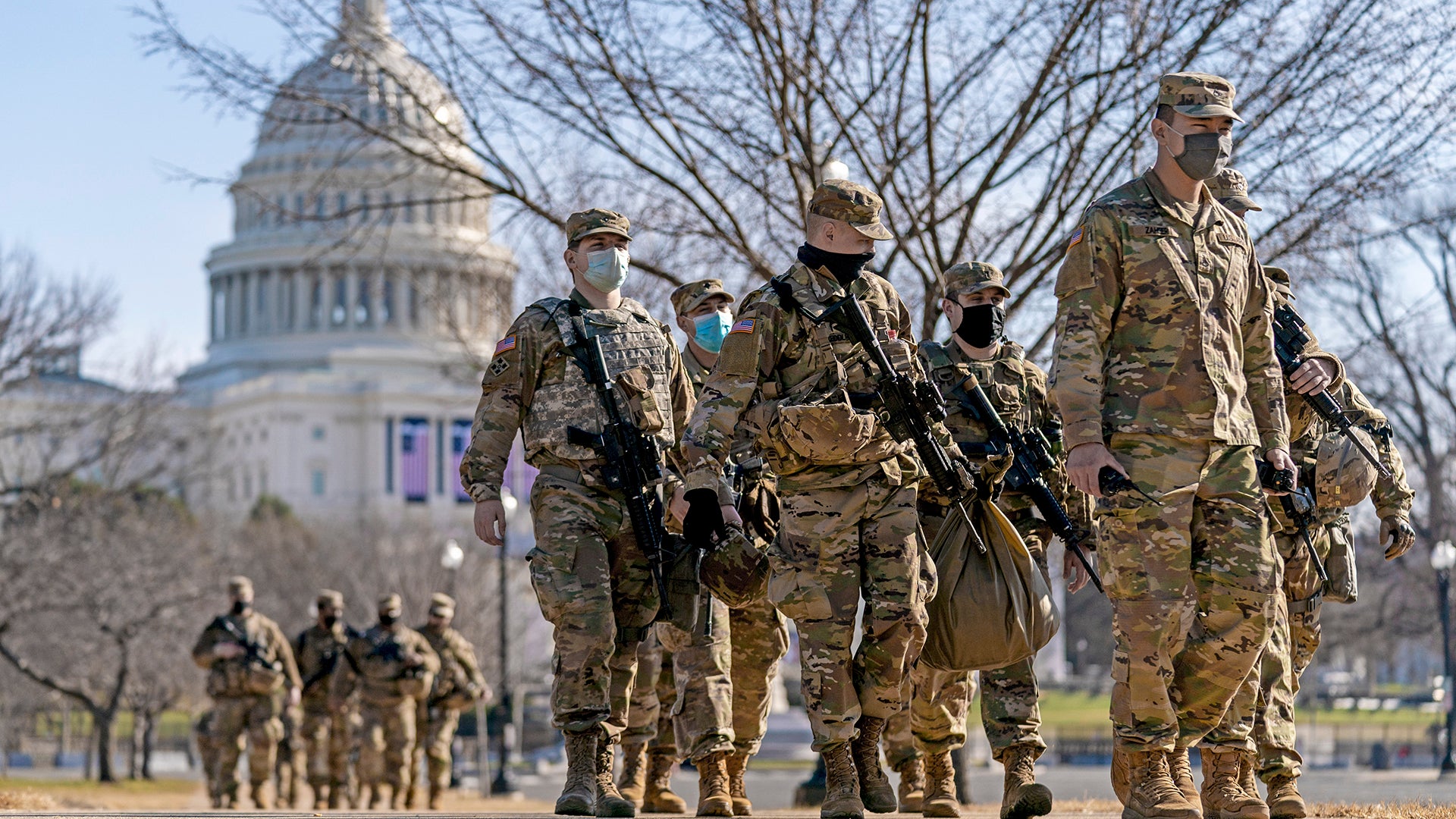America sits on the precipice of a presidential inauguration the likes of which we have never seen in our lifetime. A deeply divided nation is still coming to terms with the events on Capitol Hill on January 6, when pro-Trump protestors stormed the Capitol, chanted about hanging Vice President Mike Pence, assailed police, and ran wild through the halls of America’s seat of representative democracy. In reaction to those events and as the result of an avalanche of troubling intelligence, the center of the nation’s capital has become a locked-down fortress with thousands of law enforcement officers from an array of federal and local agencies backstopped by an unprecedented deployment of National Guardsmen to the Capital Region—set to eclipse 25,000 troops in total. That is roughly five times the amount of troops now in Afghanistan, Syria, and Iraq combined.
This 25,000 figure is in addition to active forces that are also taking part in security for the inauguration, which also number in the thousands. For comparison, 8,000 Guardsmen took part in Trump’s inauguration in 2016.
These forces are streaming in from all over the United States and beyond. There has been a steady flow of military transport aircraft arriving in the capital region to drop off these forces and their equipment. Meanwhile, large numbers of troops are not the only manifestation of extreme security for the inauguration. Fortified fencing has been erected around the vast majority of The Mall area and beyond, pushing security far out from major landmarks—most notably the Capitol and the White House—as Washington, D.C. slides into a state of quasi-lockdown.

While past inaugurations have been showcases in extreme security in their own right—you can read all about the last one in this past feature of ours—they have never been anything like this. And while the current security affair in the Capitol is militarily impressive, it is a very sad and troubling indication of the current state of the union.
What comes next is anyone’s guess. As of now, President-elect Biden is still planning on taking the oath of office in front of the Capitol, while his staff is also preparing for a number of contingencies. Regardless of reports of intelligence that points to large-scale violent acts in Washington on the inauguration day, one has to wonder how realistic this actually is at this point? Of course, small groups of nefarious actors can have a big impact, but any large groups lack proximity to the main event and are ridiculously outmatched by tens of thousands of armed soldiers and law enforcement that have been put on the highest alert. One would imagine that asymmetric threats, which are less impacted by these blunt security measures, still remain a grave security concern. Even the possibility of an attack from within the ranks of the military itself is now a concern that is being dealt with.
The reality is that chatter is just that, chatter. It has to be taken seriously, but talking about doing something and actually doing it are two different things, especially in terms of a large organized group. The loss of social media that can be used to easily coordinate planning for groups that are considered a threat is another roadblock to realizing any sort of operation of this scale. Although, that is a double-edged sword. The tradeoff between denying bad actors access to readily accessible digital communications, most notably social media, may blunt their capabilities in the near term, and to a degree in the long term, as well, but the intelligence community loses the ability to easily peer into these same groups with ease. This makes predicting future actions and even exploitable fissures within extremist elements much harder to do. These tradeoffs have been well established—the hard way—during the Global War On Terrorism.
With all this in mind, the threat of smaller groups acting around the U.S. seems to have risen possibly higher than any sort of major action occurring in Washington, and this situation is likely to exist for months, if not years to come.
Another question that is outstanding is what reverberations will the siege on the Capitol have on the average citizen’s access to major federal facilities, especially those that are major tourist attractions, in the future. How long will the fencing remain? One has to question whether things will it ever really return to how it was on January 5th, which already reflected a significantly increased security posture compared to how things were on September 10th, 2001. How hard will it be to take your family to the Capitol and to learn about its history and utility hands-on in the months and years to come? A government removed from its constituents only deepens alienation among the electorate, but balancing this against the safety of the facility and its inhabitants will be a tough proposition going forward.
Then there is the question of how this actually was able to happen in the first place. The idea that the Capitol wasn’t more fortified and there were not quick reaction teams on standby for such an event is beyond puzzling and has been a major question of security analysts, the media, and lawmakers alike since January 6th. Just the reality that there weren’t any roll-down metal gates retrofitted in the Capitol to slow an advance of a threat is mind-boggling, not to mention other passive and active measures that help do the same. Then there was the fact that those tasked with protecting lawmakers in session during such a demonstration, or at all for that matter, were equipped with mere handguns to defend the chambers—not a long gun in sight.
It’s almost impossible to fathom that after so many billions have been spent on massively enhancing the security apparatus in Washington, both above and below ground, over the last 20 years, that such an incident could take place seemingly so easily. Just imagine if there were large armed contingents in that mob or individuals with a penitent for fire-starting, or if a trained smaller force tried to make a move on the Capitol during a far lower security time frame?
The fact of the matter is we got very lucky. If there were elements within the mob that were heavily armed and had planned on executing a mass casualty event, similar to the Mumbai attacks, the result would have been almost unimaginably worse. Still, that is little consolation for the family of deceased Officer Brian Sicknick who was killed in the ordeal, or to those who were badly wounded.
While there have already been resignations or firings of the security commanders involved, including the Chief of the Capitol Police and the House and Senate’s Sergeants at Arms, this is only the beginning. Many are calling for a 9/11 Report-like inquiry regarding the siege and the failings found in such a postmortem will be extensive and damning.
The War Zone has talked to more security experts than we can count over the last week, all of which were astonished as to how many balls seemed to have been dropped at such a critical time and how naive and unimaginative the planning was for this event, or seemingly any attack on the Capitol was. This squares with the realization now that intelligence products were being circulated from the most prestigious sources, including those by the same Capitol Police that was in charge of protecting the Capitol, that such an event was not just possible, but even probable, in the days leading up to January 6th. This shouldn’t have been any huge surprise to anyone who has watched the political environment over the last four years, and especially the events following the most recent election.
All this has also led to accusations that some lawmakers even helped those who took part in the Capitol raid. These accusations are likely to be adjudicated when Congress executes the aforementioned after-action report piecing together what did and did not actually happen during the crisis. Meanwhile, the FBI is aggressively pursuing those who took part in the siege, with hundreds of cases now open and more likely to come. Obviously, this will lead to new intelligence as to what exactly people in that crowd knew and didn’t know and what help any of them were offered by those in power, whether legislators or the police, if any at all.
Although it is easy for the press to talk in monolithic terms, the reality of an event like this is that there were likely a massive range of groups and individuals all with different objectives and motives for storming the Capitol, from being caught up in the moment and following a large group, to well trained and premeditated teams of attackers. It will be interesting to see how the judicial system deals with this reality.
Now the prevailing fear is that all this was a prelude to what is to come on Wednesday. We can only hope that is not the case. What happened on January 6th wasn’t just an attack on American democracy and our collective symbols of our republic, but also the biggest gift one can imagine to our adversaries, namely Russia and China, who have longed only dreamed of such an event and the footage that came with it. Now they have January 6th to hold up as an example for years to come for propaganda and informational warfare purposes. It plays directly into their grand goals of reducing America’s claims on stability and exceptionalism through democracy.
Regardless, it is hard to imagine that things will return to normal, if there really is a normal anymore, anytime soon. With the threat that manifested itself on June 6th now distributed and fractured all over the country, things will likely be tense for the foreseeable future, especially around State Capitals and other local centers of political gravitas.
We can only hope that the powers that be will work to come to terms with the political and social issues our country is confronted with and learn to govern in a way that is far more inclusive than exclusive. The turning of politics into a WWE-like all or nothing farce has only added to all this. That in itself has become a big business. Only compromise and bipartisanship will go a long way in turning that around.
In the end, we should be Americans first, not party members or subscribers of one idealogy or another. But having lawmakers portray that to constituents and look beyond special interests and strict party lines for short-term political gains will take far more discipline than what we have seen in recent years.
We can only hope that cooler heads will prevail and somehow we can take this tragedy as a turning point to lower the partisan rhetoric and focus on what unites us, not just what divides us.
We will be covering the security situation in Washington D.C., all week. Please stay tuned for our ongoing coverage.
Contact the author: Tyler@thedrive.com
